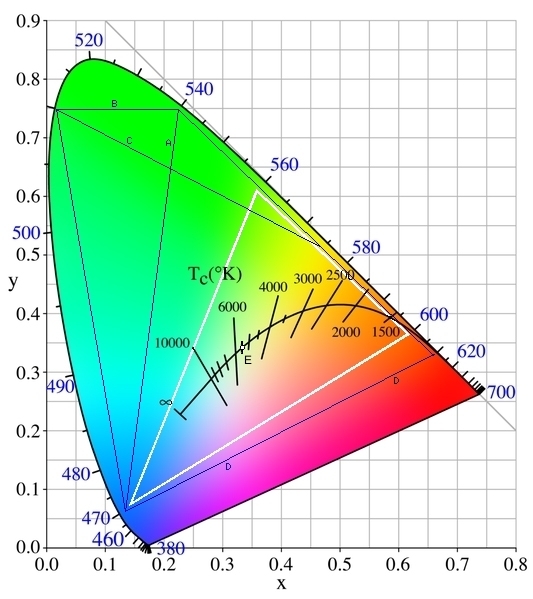
TEACH THE CORRECT COLOR THEORY
IN SCHOOLS
Teachers in public schools are still teaching
the wrong color theory to children.


|
TEACH THE CORRECT COLOR THEORY
|

|
|

The old primaries |


Part of the problem is that the old primary system (below), used with oil paints, produced these colors through abnormal mixing:
Note that these are the results of the varying concentration effects of pigments with sloped filter curves. It works in oil paints, but not with any other color medium.

Old Primaries

Old Color Wheel

New Primaries

New Color Wheel

Light Primaries

New Color Wheel

New Color Wheel
|
The Commission Internationale de l'Eclairage (CIE - the International Commission on Illumination) experimentally determined the color map at the right as a diagram of the only colors the normal human eye can see, not counting black and darker versions of the same colors (which would be under the map). The lower image is the map seen with the z-axis perpendicular to the page. The upper image is an isometric projection of the map with the plane x + y + z = 1 in the plane of the page and the zero origin directly under the 6500 K white point.
|

Isometric Projection

Orthographic Projection
|

Receptor Cell Sensitivities

Color Encoding Matrix
The color information is encoded in the retina of the eye, providing a brightness signal and two color signals, rather than a signal for each primary color:
|
Matrix Output: Expanded G-R:
Y R G B |
| Old Primaries |
Light Primaries |
Pigment Primaries |
|
| Used For Light |

|

|

|
| Used For Pigments |

|

|

|
| Used With Oil Paint |

|

|

|
| HUMAN EYE TYPE | LIGHT PRIMARIES | PIGMENT PRIMARIES |
|---|---|---|
| normal human | - red, green, blue | - magenta, yellow, cyan |
| protanomalic | - orange, green, blue | - magenta, chartreuse, cyan |
| deuteranomalic | - red, yellow, blue | - magenta, orange, aqua |
| protanopic | - green, blue | - green, blue |
| deuteranopic | - orange, blue | - orange, blue |
| tritanopic | - red, green | - red, green |
| tetartanopic | - cerise, aqua | - cerise, aqua |
| monochromatic | - blue | - black |
| cone-blind (and normal night vision) | - cyan | - black |
| ANIMAL EYE TYPE | LIGHT PRIMARIES | PIGMENT PRIMARIES |
| cat | - red, green, blue | - magenta, yellow, cyan |
| some fish | - red, green, blue | - magenta, yellow, cyan |
| dog | - yellow, cyan | - yellow, cyan |
| most nocturnal animals | - blue and rods | - black |
| some birds | - red, yellow, cyan | - purple, orange, green |
| other birds | - yellow, cyan, violet, UV | (we can't see or name them) |
| a few birds | - red, green, blue, violet, UV | (we can't see or name them) |
| most insects | - green, violet, UV | - green-UV, cyan, violet-UV |
| spiders | - green, blue, violet, UV | (we can't see or name them) |
| bees and butterflies | - yellow, green, blue, violet, UV | (we can't see or name them) |
| pit vipers | - infrared, blue | - infrared, blue |
| PRIMATES | LIGHT PRIMARIES | PIGMENT PRIMARIES |
| old-world | - red, green, blue | - magenta, yellow, cyan |
| new-world, 1/2 females* | - red, green, blue | - magenta, yellow, cyan |
| new-world, 1/2 males, 1/4 females* | - green, blue | - green, blue |
| new-world, 1/2 males, 1/4 females* | - orange, blue | - orange, blue |
| nocturnal prosimians | - blue and rods | - black |
| HUMAN EYE 4-COLOR | LIGHT PRIMARIES | LIGHT SECONDARIES** |
| normal human set 1 | - red, leaf, aqua, blue | - magenta, yellow, green, cyan |
| normal human set 2 | - red, yellow, aqua, blue | - magenta, orange, leaf, cyan |
* The X-chromosome has only one space for a color cone gene, and can take either the red or the green cone gene, but not both. The Y-chromosome can not accept a color vision gene. So males must be dichromats, but females can be either dichromats or trichromats. The dichromatic females receive two copies of the same cone gene.
** The pigment primaries are those of normal human vision. These are attempts to make a better color monitor that covers more colors, by covering more of the green curve in the CIE map.
LINKS: